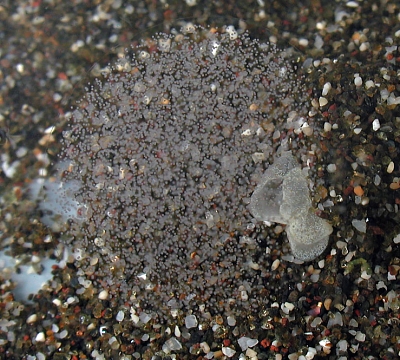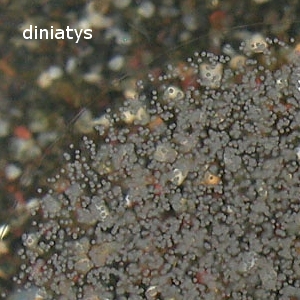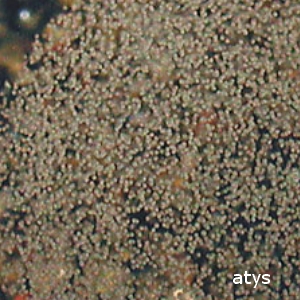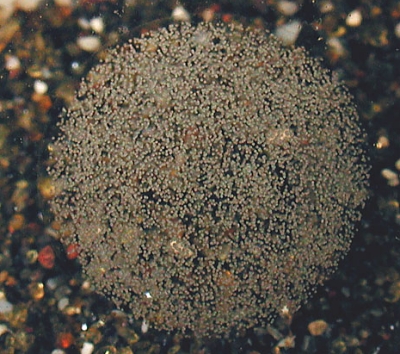Re: Different egg masses eaten by Favorinus sp. 3
May 1, 2008
From: Cory Pittman

Concerning message #21547:
Dear Bill,
I agree that the elongate egg masses are aglajid. However, I wonder if the spherical egg masses in this and other messages might have been laid be haminoeids rather than polychaetes?
I've been holding Cephalaspidians in dishes for many years and quite a few have laid eggs for me. Although the genus Haminoea lays elongate egg masses that have spiral egg strings and adhesive surfaces, the genera Atys and Diniatys lay spherical masses that have randomly distributed eggs and are anchored by mucous strings. In two cases, I've caught them "in the act" and the envelope appears to be produced first, then the eggs are "blown" into it in small puffs inflating it like a balloon. Depending on species, the egg masses may be anchored in sand, algal turf or both. And, sand dwelling species may remain largely beneath the surface while laying. I've attached photos of two examples. The first shows a Diniatys laying an egg mass in one of my dishes. The animal was 10 mm in length and the egg mass 10.5 mm in diameter when finished. It was collected at a depth of less than 1 m at Hekili Point, Maui on October 5, 2002. The second shows an egg mass of Atys debilis. It was 8 mm in diameter. The animal was collected from between 14 m and 17 m at Black Rock, Maui on April 29, 2005. As you can see, they're very similar to some polychaete egg masses making it difficult to distinguish the two with certainty in the field or in photos.
Locality: Maui, Hawaii, Pacific. Photographer: Cory Pittman.
Best wishes,
Cory
cory@cet.com



Dear Cory,
Thanks for these photos I agree distinguishing polychaete egg masses from those of cephalaspideans in the field or from photos is quite difficult. In the field I tend to go for rigidity - worm egg masses seem to be much 'floppier' - and egg size - worm eggs seem to be much smaller. But these are of course 'feelings' you pick up with experience and not really measurable. The only thing I can look for in photos is whether the eggs seem to be arranged in strings. As I am sure you know opisthobranch eggs are all linked together in a long chain, while eggs of those polychaetes that lay their eggs in mucous bags like this, are not linked together. I have included a close-ups of both your egg masses and am pretty sure that I can see strings of eggs in both cases which is what I would expect to see. However, as I can only see a few short strings, it's not a foolproof test.
If you feel like it, or have the time, it would be nice to have series of photos of the different egg masses you have observed.
Best wishes,
Bill Rudman
Related messages
-
Re: Nudi in a Bubble
From: Tony Wu, April 19, 2010 -
Re: Nudi in a Bubble
From: Tony Wu, April 19, 2010 -
Nudi in a Bubble
From: Jeff Davies, September 30, 2009 -
Re: Favorinus sp. 3 ? from East Timor
From: Brian Francisco, July 21, 2008 -
Favorinus sp. 3 ? from East Timor
From: Brian Francisco, July 17, 2008 -
Several type of egg mass that Favorinus sp. 3 eat
From: Ayumi Murakami, April 30, 2008 -
Egg-eating aeolids from Japan
From: Ayumi Murakami, April 30, 2008 -
Photos of an egg-eating aeolid
From: Terry Gosliner, August 11, 2000 -
Re: egg-eating Favorinus
From: Terry Gosliner, July 30, 2000 -
Re: egg-eating aeolids
From: Denise Nielsen Tackett, July 28, 2000 -
Nudibranchs inside egg cases
From: Denise Nielsen Tackett, July 17, 2000
